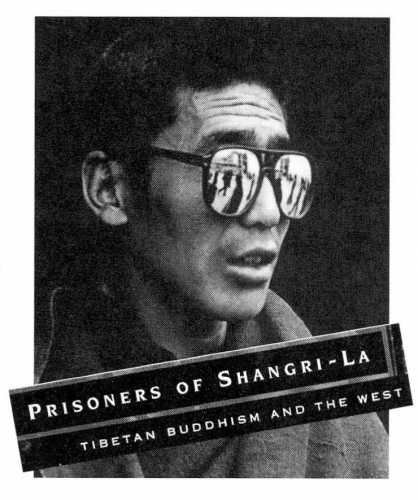Prisoners of Shangri-La: Tibetan Buddhism and the West
Donald S. Lopez, Jr.
University of Chicago Press: Chicago, 1998
275 pp. $25.00 (cloth)
Can we, in the market-driven societies of the contemporary West, really find our way to the spiritual wellsprings of non-Western cultures? And if we take a closer look at the supposedly pure waters of those religions, will we find that, once again, we have taken as the fundamental truth only a reflection of ourselves?
Those willing to pursue such sticky questions will find Donald Lopez’s fascinating Prisoners of Shangri-La a provocative exploration. Lopez conveys the full dizziness of the Western encounter with Tibet and Tibetan Buddhism, from the first European missionaries and travelers, through the imperialists, spies, philologists, and Theosophists of the nineteenth and early twentieth centuries, and on to the film stars and Buddhological academics of today. Each of his book’s six chapters focuses on a different key object, icon, text, or institution in what—following Michel Foucault—we might call the whole “discursive regime” that constitutes Tibetan Buddhism in the contemporary West. Lopez reveals, for example, that in traditional Tibetan culture the mantra Om mani padme hum doesn’t actually mean “the jewel in the lotus” but is rather a straightforward invocation, a calling out and taking within, of Avalokitesvara, the bodhisattva of compassion. He speculates on the significance of the ridiculous popularity of The Third Eye by T. Lobsang Rampa, a.k.a. Cyril Hoskins, the paranoid and pathetic Englishman who wrote it. And he charts how the collection of Tibetan texts known in the West as The Tibetan Book of the Dead have mutated into one of the most wildly misinterpreted—and influential—“spiritual classics” of New Age culture.

Lopez is at his best on this point, particularly when he illuminates the degree to which the Tibetan community-in-exile itself has been complicit in the delusion that Tibet was a timeless “land free from strife, ruled by a benevolent Dalai Lama, his people devoted to the dharma and . . . the preservation of the environment and the rights of women.” It is refreshing to read the work of a Buddhist scholar willing to draw on contemporary critical theory—from the cultural sociology of Pierre Bourdieu to the deconstructive strategies of Paul de Man—to analyze the complex revisions in the meanings of “Tibet” and “Tibetan Buddhism.” In Lopez’s hands, we see how such theoretical tools can help us shift our focus away from the supposedly intrinsic meanings of a cultural tradition to the multiple, shifting usages out of which the very notion of a tradition is extracted and congealed by particular groups for particular strategic reasons of their own—as today, for example, in the movement to free Tibet from Chinese rule. But the force of Prisoners of Shangri-La is somewhat weakened by a fundamental inconsistency: Lopez himself is not altogether immune to the temptation to search out the authentic meanings to be found at Tibetan Buddhism’s unchanging core. In the chapter on Om mani padme hum, for example, he is overridingly concerned with conveying the “real” meaning and “authentic” use of this mantra as it is understood and employed by Tibetans. But by the end of the next chapter, on Tibetan artwork, he has swung back to the genial concession that “perhaps what we call ‘Tibetan art’ or ‘Tibetan Buddhism’ is already uncontrollable,” and that therefore “it is in the renunciation of the compulsion to control”—that is, to fix an authentic, permanent meaning to either of these terms—“that a certain liberation might lie.”
So, Lopez appears alternately as academic and devotee, as hip Western deconstructor and guardian of Eastern tradition. Yet perhaps the confusion in Prisoners of Shangri-La is a condition that neither he nor his Western readers can wholly avoid. Those of us who, like Lopez, are products of this culture, often find ourselves caught between a desire to submit to the practice, study, and devotion indigenous to the great traditions of Asian Buddhism and the urge to adapt those forms to our own First World, late-twentieth-century lives. After all, such shifting and accommodation also took place, albeit over centuries, in what we now think of as the country of Tibet—even as its sages, too, proclaimed that they were passing along the timeless Buddhist truths and practices they had received from beyond.
Thank you for subscribing to Tricycle! As a nonprofit, we depend on readers like you to keep Buddhist teachings and practices widely available.